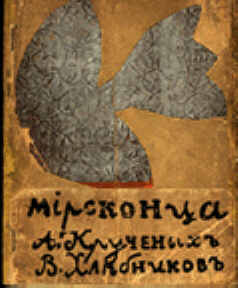
Mirskontsa (Worldbackwards)
(Goncharova, Larionov, Tatlin, Rogovin)
A. Kruchenykh and V. Khlebnikov
G.L. Kuzmin and S.D. Dolinsky, Moscow, 1912. Edition: 220.


Mirskontsa (Worldbackwards)
(Goncharova, Larionov, Tatlin, Rogovin)
A. Kruchenykh and V. Khlebnikov
G.L. Kuzmin and S.D. Dolinsky, Moscow, 1912. Edition: 220.
Considered to be the most significant book produced by the Donkey's Tail collective, Worldbackwards offers tremendous insight into the innovation, ingenuity, and enthusiasm which existed among the members the Russian avant-garde. Mirskontsa is illustrated throughout with primitivistic and avant-garde works by Goncharova, Larionov, Tatlin and Rogovin, and each copy features a one-of-a-kind, handmade collage by Goncharova.Driven by the desire to restore Russian culture to its true nature by extracting all traces of foreign influence, members of the Donkey's Tail collective, in a quest for absolute primitivism, looked to the past for inspiration: Writers turned to folk-tales and mythology, while artists turned back even farther to the line drawings found on rocks and in caves.
Created as a deliberate attempt to clash against the traditional notions of aesthetic order and organization, Mirskontsa features pages whose color, content, text and type-face vary from one to the next. The text, composed by Khlebnikov and Kruchenykh, is produced through a wide variety of printing processes, including rubber-stamps, stencils, potato-cuts, and mimeographs from handwriting. Typographic innovations include the use of words deliberately misspelled, letters printed backwards and upside down, an arbitrary use of capital and lower cases, letters of different shapes and styles, and letters which were transcribed by hand. Some pieces, printed at an angle, demand that the reader rotate the book to read them, and others are completely hand-written.
(Howard Schickler)
Photos thanks to Howard Schickler Fine Art, where you can find Russian books of this period.
Look at other Futurist books
Look at contemporary artists' typography influenced by the futurists
See how letterforms were used as illustration and pages designed as a totality in an Egyptian papyrus
See an Arabic illuminated manuscript
Look at a Hebrew illuminated manuscript
Look at Fluxus work which was influenced by the Futurist aesthetic
Look at other forms of writer and artist collaborations in the twentieth century